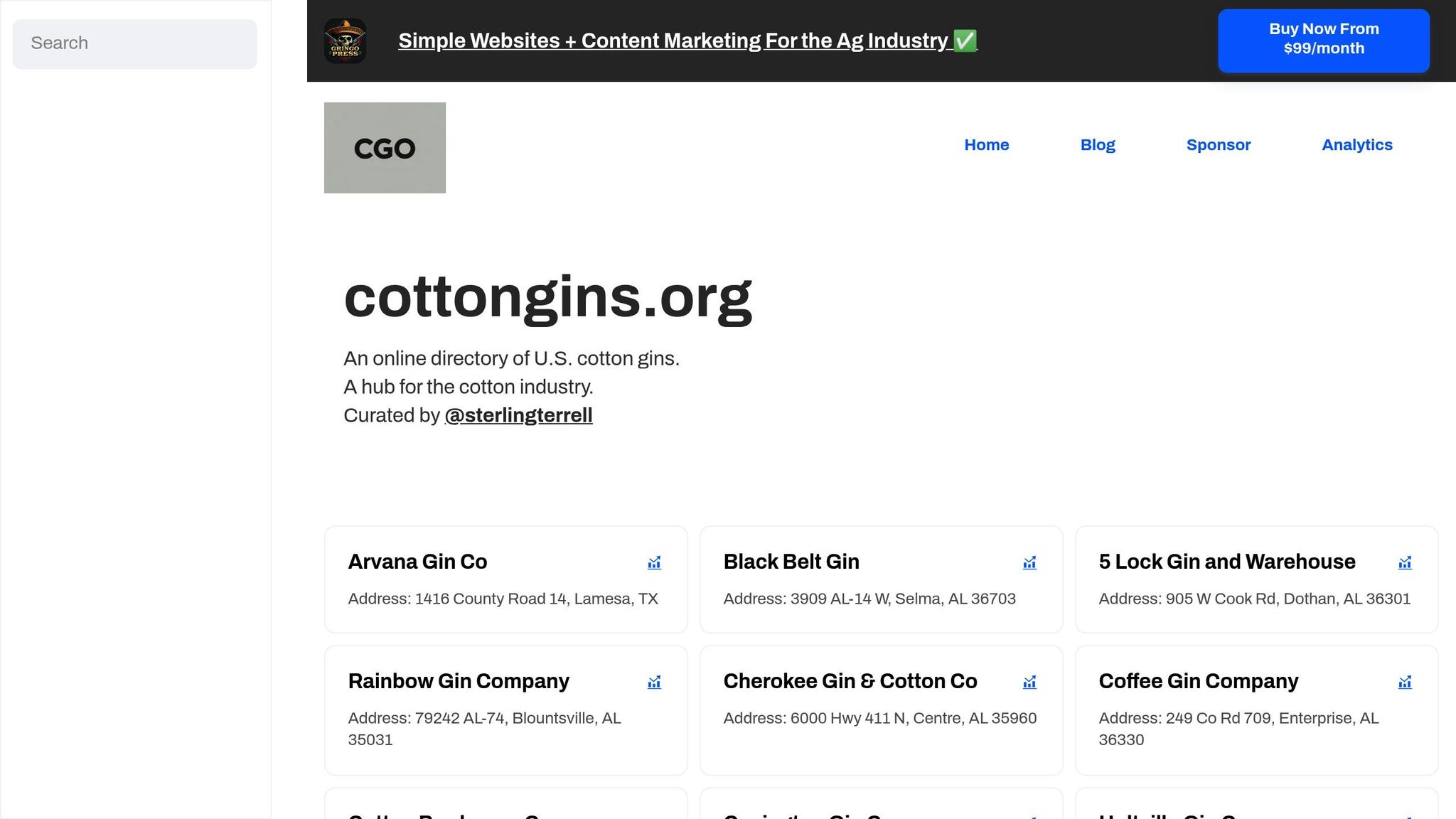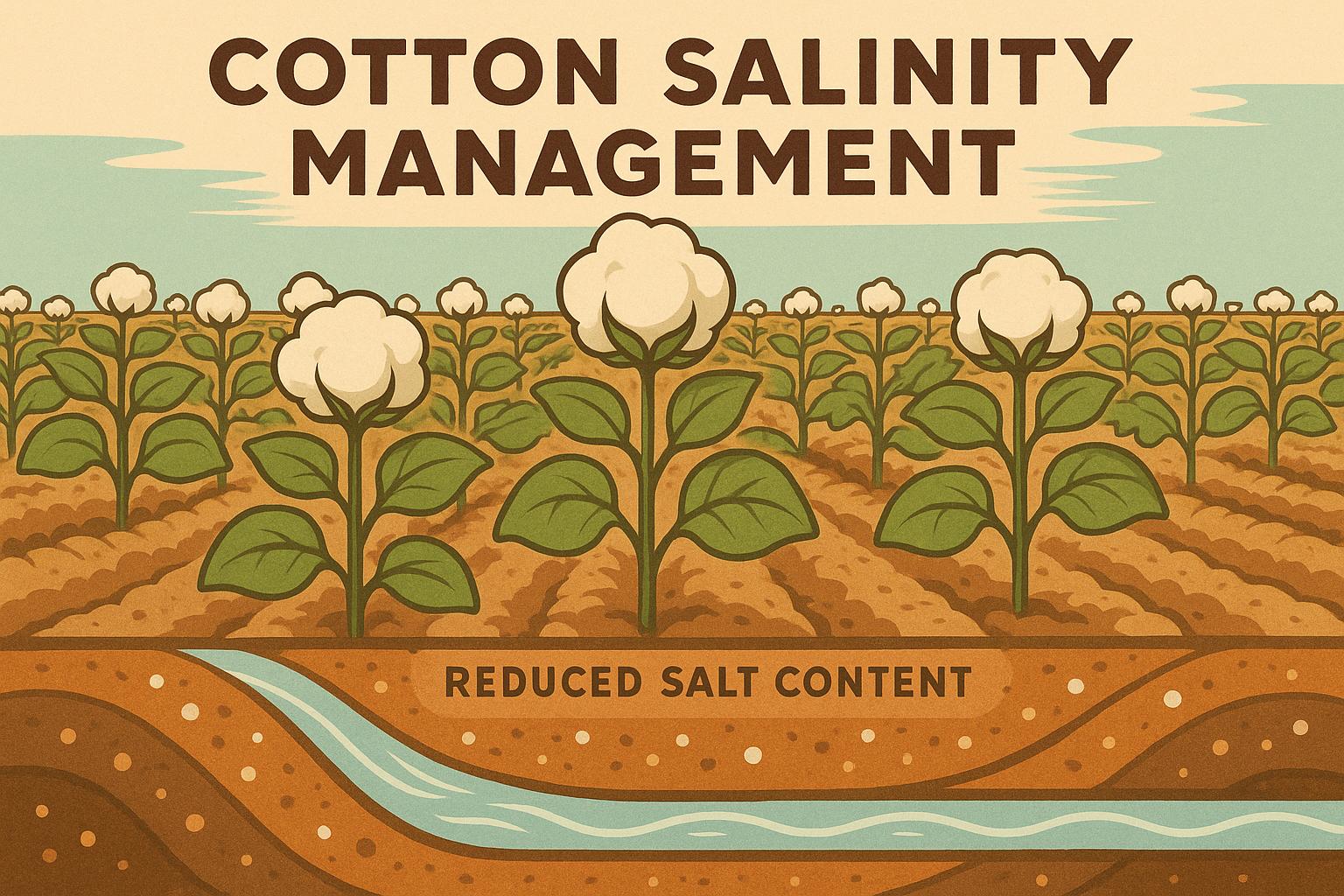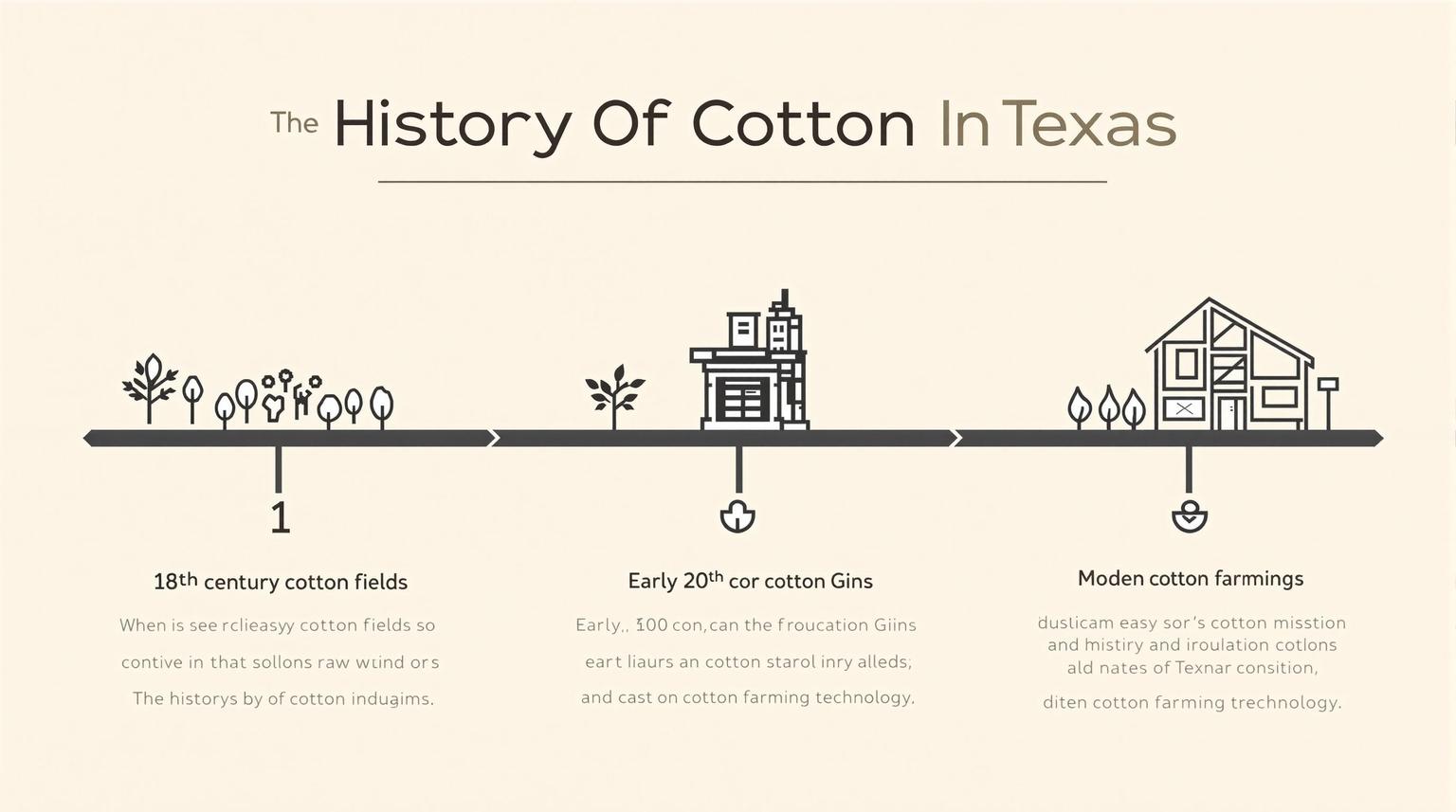Energy monitoring helps cotton gin operators cut costs by identifying inefficiencies in energy use. With electricity accounting for 17% of ginning costs - about $4.18 per bale - tracking energy consumption in real-time can significantly improve profitability. Key areas of waste include air leaks, over-drying, and poor material flow. Advanced tools like motor load sensors and moisture controllers provide actionable data to fix these issues, prevent equipment breakdowns, and optimize operations. By addressing inefficiencies, operators can save on electricity, fuel, and maintenance, making energy monitoring a practical solution for reducing expenses.
Key Takeaways:
- Electricity Costs: 17% of total ginning expenses ($4.18/bale).
- Common Energy Wastes: Air system leaks, over-drying, and unsynchronized equipment.
- Savings Potential: Moisture control systems can reduce fuel costs by up to 50%.
- Tools: Real-time monitoring systems, smart controls, and remote troubleshooting.
Investing in energy monitoring systems not only reduces costs but also improves operational efficiency, ensuring long-term savings.
Common Sources of Energy Waste
Cotton gin operators often encounter several areas where energy is wasted, leading to increased operational costs. Key culprits include inefficiencies in air handling, drying processes, and material flow. Fortunately, energy monitoring tools can quickly identify and help resolve these issues, providing opportunities for significant cost savings.
Air System Problems and Leaks
Air handling systems are some of the biggest energy consumers in cotton gin operations. Leaks in ductwork or loose connections force fans to work harder, wasting energy as the system attempts to compensate. Similarly, running fans at full capacity when demand is low leads to unnecessary energy use and higher expenses. With the help of monitoring tools, these leaks can be identified and repaired promptly, reducing energy bills.
Drying System Problems and Over-Drying
Drying systems are another major source of energy waste, especially when moisture levels aren't properly controlled. Over-drying cotton - beyond the recommended 5–6% moisture content - uses extra fuel without improving the quality of the final product.
Studies show that unreliable moisture sensor data often results in over-drying, significantly increasing fuel consumption. For example, drying fuel usage can climb from 248 to 312 cubic feet per bale under such conditions, driving up costs over time. Many facilities over-dry cotton as a precaution when they lack dependable moisture sensor data, even though this practice is costly.
Current benchmarks reveal that drying typically requires between 0.74 and 3.90 cubic meters (around 26 to 138 cubic feet) of natural gas per bale, highlighting the potential for energy savings.
"Effective moisture and temperature sensors and controllers are essential to obtain proper dryer control so that unnecessary drying is avoided." - W. Stanley Anthony, Supervisory Agricultural Engineer and Research Leader, Agricultural Research Service, USDA
Research supports this claim, showing that accurate moisture measurement and control systems can cut fuel costs by as much as 50%.
Poor Material Flow Management
Inefficiencies in material flow management can also waste significant energy. Mismatched equipment capacities and poorly synchronized operations cause motors to frequently start at full power, which is far less efficient than running at a steady, optimal load. For example, unsynchronized gin stands, cleaners, and conveyors often force equipment to operate at full power unnecessarily.
The extent of this waste becomes clear when considering that the benchmark electricity consumption for ginning operations ranges from 44 to 66 kWh per bale. Inefficient trash handling only adds to the problem, as excessive use of conveyors and fans further increases energy demands.
How Energy Monitoring Cuts Costs
Building on the discussion of energy waste sources, energy monitoring systems give operators the tools to tackle inefficiencies and reduce expenses. By offering real-time insights, these systems enable proactive maintenance and smarter operations. Let’s explore how they collect data, prevent equipment failures, and boost operational efficiency.
Real-Time Data Collection and Analysis
Modern energy monitoring systems continuously track key parameters like temperature, humidity, and machinery performance. This constant flow of data allows operators to detect inefficiencies as they happen, making it easier to act quickly and prevent minor issues from spiraling into major problems.
The immediate impact? Cost savings. For example, the gin stand ranks as the second-largest electricity consumer in cotton gins. Systems like Lubbock Electric Co.'s Touch Screen Master Gin Console illustrate the benefits of real-time monitoring. This tool gives operators a complete overview of the cotton gin, while its intelligent motor load sensing identifies issues promptly, reducing downtime and maintaining optimal ginning speeds.
"We put the power of automation and remote monitoring in your gin, reducing your labor costs and increasing employee safety. Plus, with more data in your fingertips, you'll have the power to take action that prevents loss and downtime." - Lubbock Electric Co.
Preventing Equipment Breakdowns
Energy monitoring goes beyond data collection; it acts as an early warning system. By identifying motor overloads or potential fire hazards early, these systems help operators avoid costly equipment failures. Consumption patterns are analyzed to detect anomalies, signaling potential issues before they escalate.
This is especially important in cotton gins, where many motors operate at less than 40% capacity, leading to inefficiencies that monitoring systems can address. Advanced controllers now come equipped with features like automatic load sensing and motor overload protection to safeguard equipment.
"We design all of our controls around protecting and prolonging the life of your motors." - Lubbock Electric Co.
Remote monitoring adds another layer of efficiency. It allows operators to troubleshoot problems quickly without needing on-site technicians for every issue, cutting down on labor and service costs.
Using Energy Data to Improve Operations
Energy data provides cotton gin operators with the insights needed to fine-tune their processes. By analyzing real-time data, operators can adjust fan speeds, calibrate dryers, and synchronize equipment, directly reducing energy waste. This approach replaces guesswork with actionable metrics.
The potential for savings is substantial. Cotton handling alone accounts for nearly 50% of total power usage in cotton gins, while packaging and handling together make up about 70% of the energy consumed. Detailed monitoring also highlights how variables like trash content, moisture levels, and cotton variety influence energy use, helping operators optimize their operations.
Real-time data doesn’t just improve energy efficiency - it also supports broader decision-making. Operators can use this information to manage inventory, forecast demand, and streamline logistics. By turning energy costs into a controllable factor, monitoring systems help maximize profitability.
Practical Ways to Cut Energy Costs
Understanding where energy waste occurs is just the first step; the real savings happen when you take action. Cotton gin operators can implement specific strategies to address major energy drains and reduce costs effectively.
Fixing Air Leaks and Ductwork
Pneumatic conveying systems are responsible for about 50% of a cotton gin's electrical energy usage, making air leaks a costly problem to overlook. Using energy monitoring tools can help pinpoint leaks, allowing for precise repairs that save energy and money.
Paul A. Funk, an agricultural engineer with the USDA–ARS, highlights the importance of a holistic approach:
"Pneumatic conveying represents 50% of the electrical energy used by a typical gin. Usage can be reduced by sealing leaks in air ducts, minimizing turbulence before and after fans, reducing pressure drops by simplifying flow paths, and using mechanical conveyors where practical."
Start by sealing ductwork, focusing on areas where pressure drops unexpectedly - this often indicates leaks. Pay attention to joints, connections, and bends in the duct system, as these spots are more prone to air loss.
Beyond sealing, improving the design of the ductwork can significantly enhance efficiency. Reducing turbulence around fans by using smooth transitions, proper spacing, and avoiding sharp bends can make airflow more efficient. Simplifying the layout of the pneumatic system by eliminating unnecessary routing also helps minimize pressure drops and reduces energy demand.
Installing Automatic Drying Controls
Outdated drying controls are another source of energy waste, often leading to over-drying and mismanaged fuel use. Modern automatic controls, informed by energy monitoring data, can significantly lower fuel costs.
Moisture measurement and control systems have been shown to cut fuel expenses by up to 50%. For example, in 2004, these systems saved nearly $1.00 per bale, with projections suggesting savings could reach $2.50 per bale in later years.
W. Stanley Anthony, Supervisory Agricultural Engineer at USDA's Agricultural Research Service, stresses the importance of precision in drying controls:
"Effective moisture and temperature sensors and controllers are essential to obtain proper dryer control so that unnecessary drying is avoided."
He adds:
"Not only does a modern control system yield obvious safety advantages, it also gives the drying system much more rapid and accurate response capability. If the system is able to change temperatures rapidly in very small increments, fuel can be conserved by using only what is required at a given moment."
Modern systems replace outdated on/off temperature controls with more advanced features, enhancing both safety and efficiency. Key components for optimal fuel savings include double safety shutoff valves, automatic ignition, flame failure shutoff, modulating valves, temperature-limiting devices, and accurate moisture sensors. By measuring moisture levels before and after drying, these systems adjust automatically to meet real-time needs, avoiding wasteful fixed settings. Regularly monitoring these systems ensures consistent energy savings over time.
Tracking Performance Over Time
Once initial fixes are in place, tracking performance over time can turn real-time data into long-term improvements. With energy costs accounting for 27% of variable expenses in cotton gins, even small efficiency gains can lead to substantial savings.
The potential for savings is massive. For example, in 2010, a 1.5% reduction in electricity use could have saved U.S. cotton ginners $1,000,000. Operating equipment at full capacity is one of the most effective ways to avoid energy waste, as underutilized machinery often consumes unnecessary energy.
Avoiding equipment idling for more than a few minutes is another critical step. Performance benchmarks provide valuable insights; for instance, in 2010, some gins used less than 40 kWh per bale, with averages of 31.4 and 25.8 kWh per bale recorded at two facilities during the 2011 season.
Comparing performance across shifts can uncover operational differences that affect energy use, while monitoring seasonal variations can reveal how factors like cotton moisture and trash levels impact consumption. Regular reviews should prioritize the largest energy consumers first, as these areas offer the greatest potential for efficiency improvements.
sbb-itb-0e617ca
Using Industry Resources for Better Efficiency
Industry directories play a key role in connecting professionals and providing data that can help reduce energy costs. These tools work hand-in-hand with energy monitoring systems, offering actionable strategies to improve efficiency.
How cottongins.org Supports Cotton Gin Operators

The cotton ginning industry benefits significantly from resources like cottongins.org, a directory that connects operators across the U.S. This platform allows operators to compare performance metrics and exchange ideas for improving efficiency.
For operators seeking to evaluate their energy use, access to a comprehensive directory is invaluable. It provides insights into how other facilities manage their energy consumption, offering practical ideas for improvement. Additionally, operators can contribute by submitting new entries, ensuring the directory remains up-to-date and reflective of the industry’s current state. This makes it easier to identify potential collaborators for strategies like bulk purchasing of energy-efficient equipment or sharing energy monitoring techniques.
The platform also offers a mailing list that keeps operators informed about industry news, advancements in energy-saving technologies, and regulatory changes. Staying updated through these channels enables operators to make well-timed decisions regarding energy investments and upgrades, fostering better operational efficiency.
This level of connectivity not only streamlines communication within the industry but also encourages cost-saving collaborations.
Exploring Sponsorship and Partnership Opportunities
Strategic partnerships can significantly amplify energy-saving efforts and operational improvements. cottongins.org provides sponsorship options that connect operators with providers of energy monitoring solutions and efficiency-focused equipment.
- Sponsored Posts: For $200 per post, operators can share success stories about their energy-saving initiatives. This not only highlights their achievements but also attracts potential partnerships with solution providers or consultants specializing in gin efficiency.
- Official Sponsor: At $200 per month, sponsors gain consistent visibility through logo placement and backlinks.
- Featured Sponsor: For $400 per month, sponsors receive top placement along with additional promotional benefits.
These sponsorships offer a platform for operators to showcase their expertise in energy efficiency while helping others learn from their strategies. Organizations like Cotton Incorporated, which supports efforts to evaluate energy use in ginning labs, demonstrate the industry’s commitment to sharing knowledge on energy improvements.
Beyond advertising, these sponsorships foster valuable connections. Operators often find themselves networking with equipment manufacturers, energy monitoring providers, and peers facing similar challenges. These relationships can lead to group purchasing deals for equipment, shared consulting services, or collaborative energy efficiency projects across multiple facilities. This kind of cooperation not only benefits individual operators but also strengthens the industry as a whole.
The Future of Energy Efficiency in Cotton Gins
Cotton gins are stepping into a new era of energy management, driven by advanced technologies that promise to cut costs and improve efficiency. With precision agriculture technologies evolving rapidly, operators who adopt energy monitoring systems now will be better prepared to take advantage of new innovations.
Artificial intelligence (AI) and machine learning are already making waves in agriculture, with projections suggesting that over 60% of large farms will implement AI-powered precision technologies by 2025. For cotton gins, these advancements translate into smarter systems capable of detecting inefficiencies, predicting equipment issues before they occur, and optimizing energy usage across operations.
The rise of IoT sensors and cloud-based solutions is also transforming how cotton gins operate. By creating digital twins - virtual models of their facilities - operators can simulate various scenarios, test energy-saving strategies, and oversee performance across multiple locations from a single dashboard. Remote sensing further enhances this capability by providing detailed insights into equipment performance, air systems, and drying operations. These tools are not just about saving energy - they also open the door to innovative approaches like carbon utilization.
Carbon utilization, in particular, is gaining momentum. As Hadar Sutovsky, Vice President of Corporate Investments at ICL, explains:
"Carbon utilization is evolving from a niche concept to a cornerstone of sustainable agriculture. With AI-driven MRV technologies and carbon farming initiatives, agriculture is actively contributing to climate solutions."
By adopting comprehensive energy monitoring systems, cotton gin operators can document their efficiency gains more effectively, potentially unlocking additional revenue opportunities.
Collaboration within the industry is also playing a key role. Platforms like cottongins.org are helping operators connect with solution providers, offering sponsorship opportunities and paving the way for future tools like performance benchmarking and group purchasing programs for energy monitoring equipment.
Investing in these systems today not only builds expertise but also ensures readiness for next-generation technologies like AI, predictive maintenance, and automated controls. Waiting too long could mean falling behind competitors who are already leveraging these tools.
Other agricultural sectors highlight the potential impact of such advancements. For instance, almond farmers in California using AI tools like Semios have slashed pest damage by over 50%, significantly reducing costs. This example underscores the transformative power of technology in agriculture.
The combination of energy monitoring, AI, and industry collaboration - fueled by platforms like cottongins.org - offers a unique opportunity for cotton gins to achieve greater efficiency and cost savings. Those who act now will not only lead the way in sustainable cotton processing but also set the stage for broader industry innovation.
FAQs
How can energy monitoring systems help cotton gins save on electricity costs?
Energy monitoring systems give cotton gin operators a clear picture of how electricity is being used, helping them cut down on unnecessary costs. By analyzing energy data, operators can spot equipment that’s using too much power or running when it’s not needed. This insight allows for smart adjustments that reduce waste and keep operations running smoothly.
When machinery runs efficiently and idle times are kept to a minimum, electricity bills drop without sacrificing productivity. This kind of proactive energy management not only saves money but also promotes more environmentally friendly practices over time.
What tools and technologies can help cotton gins save energy and reduce costs?
Modern tools and technologies are transforming how cotton gins identify and tackle energy inefficiencies. Computerized gin control systems enable operators to monitor and fine-tune operations in real time, ensuring everything runs as efficiently as possible. Sensors that measure factors like temperature, humidity, and machine performance provide critical insights, helping operators zero in on areas that need improvement. On top of that, advanced energy monitoring systems track electricity usage, making it easier to spot waste and implement energy-saving changes.
By using these technologies, cotton gin operators can cut down on energy costs, streamline processes, and keep operations running smoothly - all of which contribute to better profitability.
How can real-time energy monitoring help cotton gin operators save money and avoid equipment failures?
Real-time energy monitoring gives cotton gin operators the ability to keep a close eye on energy consumption and equipment performance. This helps pinpoint inefficiencies and fine-tune operations for better results. By catching irregularities early, operators can tackle potential problems before they escalate into expensive breakdowns or unplanned downtime.
With this data-driven method, gins can cut down on energy waste, boost productivity, and prolong the life of their equipment. These benefits translate into reduced operational costs. Investing in energy monitoring tools is a practical step toward ensuring smooth and efficient cotton gin operations.


